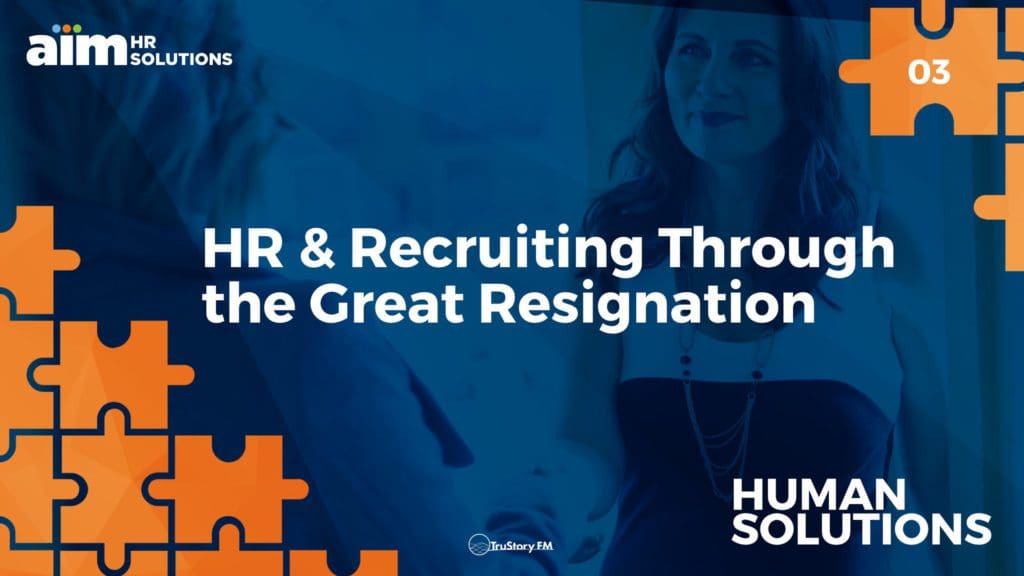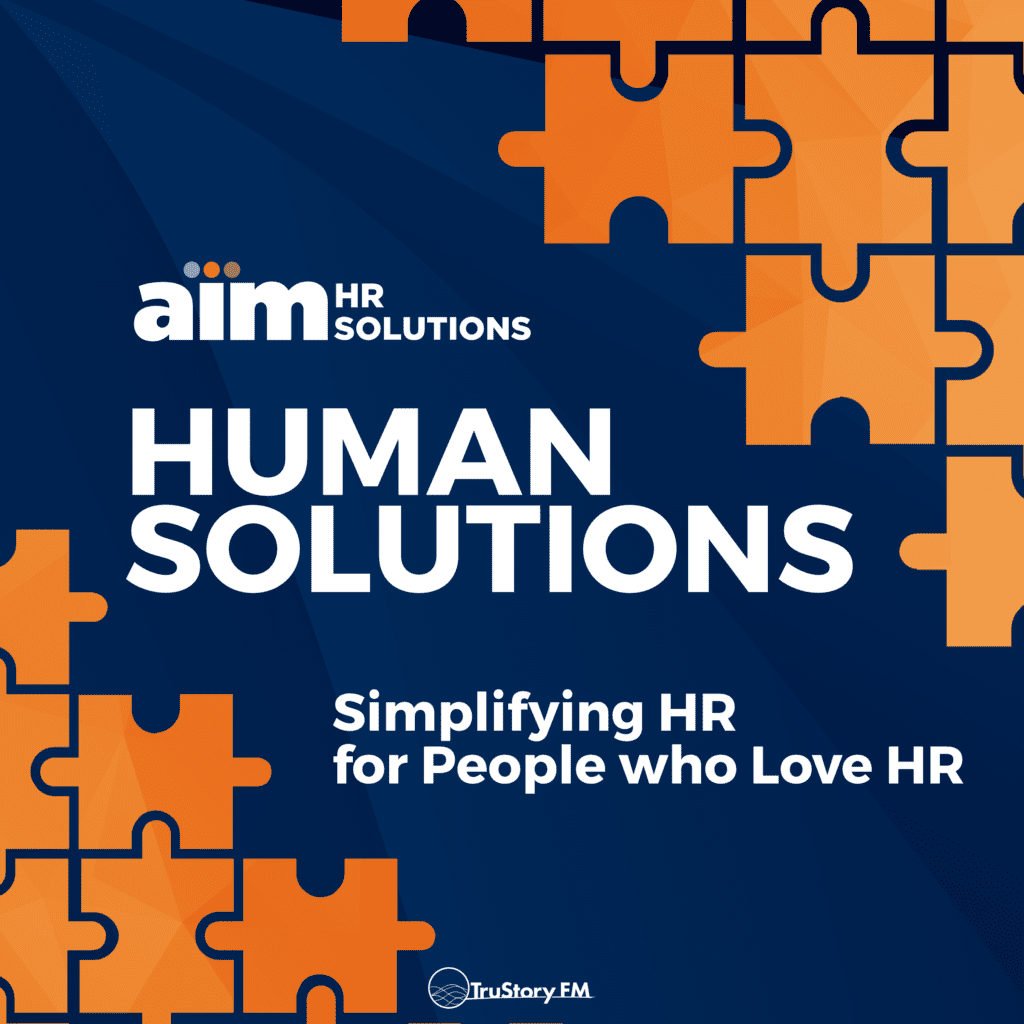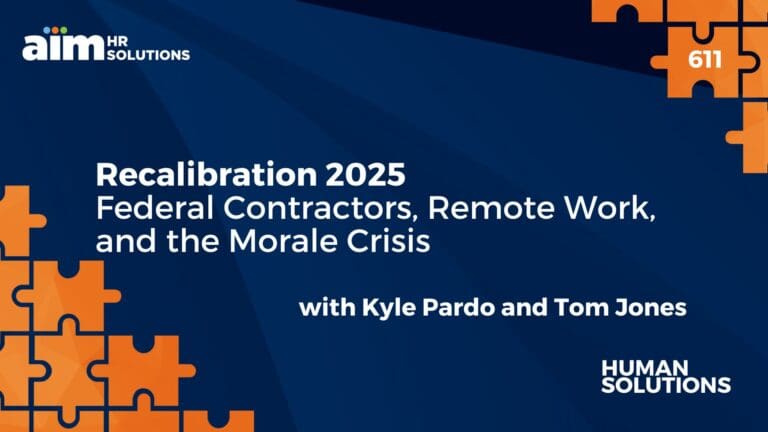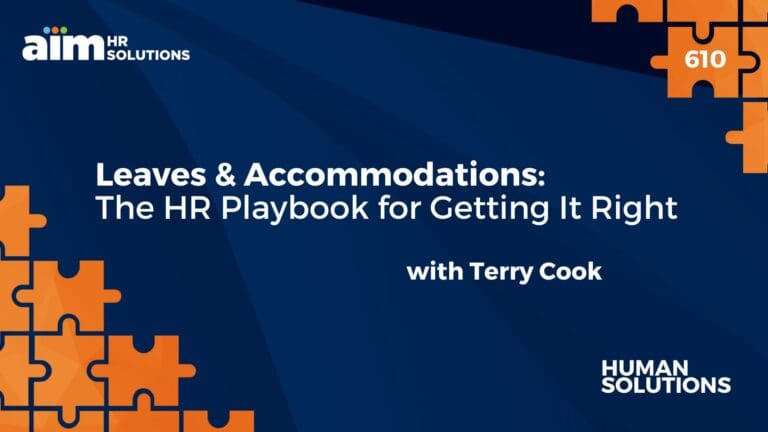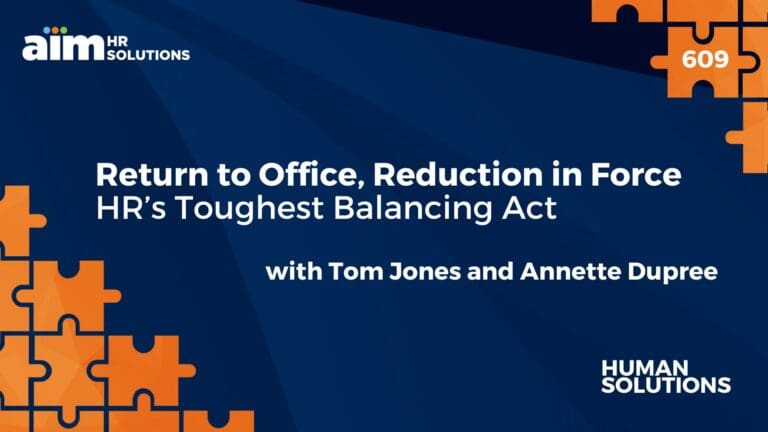Recruiting competition is peaking as we navigate the hiring environment now that the pandemic restrictions are lifting around us. The world is going back to work. But things are not the same as they were; job seekers are more selective than ever and getting them in the door is forcing hiring managers to rethink, regroup, and retool their processes.
Today, Kyle Pardo, our Executive Vice President, and Terry Cook, our Senior Vice President of Employer Services, join Pete Wright to talk about what employers and managers are doing to recruit, retain, and appeal to job seekers in the era of the Great Resignation.
Episode Transcript
Pete Wright: Welcome to Human Solutions: Simplifying HR For People Who Love HR from AMHR Solutions on TruStory FM. I’m Pete Wright, and this week we’re talking all about the great resignation, a hot topic across the vast news cycle. The behavior and expectations of employees at work has changed dramatically in the turmoil of the last few years. One constant theme we’re hearing from employers is how do you recruit in this labor market? Today, Terry Cook, our Senior Vice President of Employer Services and frequent guest on this podcast now, and Kyle Pardo, AMHR Solutions Executive Vice President join me to share their perspectives on how employers can navigate the challenge of recruiting in 2022 and beyond. Welcome Terry and Kyle, we’re going to talk about hiring. It is an uncertain market. Would you agree?
Terry Cook: Yes, I would definitely say it’s an uncertain market. We’ve been hearing a lot about that from many companies.
Pete Wright: So we want to talk about that today. We want to take this on and stare it straight in the eyes. People left the workforce in the wake of the pandemic, for many different reasons. Two questions for you to start. Are they coming back, and what is it that’s getting them through the door?
Terry Cook: Sure. So are they coming back? Yes, I would say there are definitely increases in people coming back into work, but what they’re looking for has changed. So what I mean by that is some people have decided that they don’t want to go into work face-to-face any longer. They want to have a remote or even a hybrid option where they can do a little bit of both. Now that could be because they’ve gotten used to it, and they’ve enjoyed it during the pandemic, or it could be for legitimate reasons where they cannot be in-person in a workplace right now, whether that be a risk to themselves or others that they might be around. So I think people are coming back, maybe not full numbers coming back yet, but how they’re coming back is different. And to your second question, what they’re looking for to get into the door, as I mentioned is different. I tell workplaces all the time, flexibility is key, how you actually sell the opportunity and the company to your candidate is in the forefront now. That’s what’s bringing people in the door.
Pete Wright: We’re challenging a lot of long-held assumptions about what it means to work together. It feels like one of the huge discoveries is that in fact, you can get work done for many people, not sitting in a workplace. Kyle, what’s are you seeing? What’s your observation here? What are we pushing against in terms of these cultural norms, and are organizations starting to adapt?
Kyle Pardo: Yeah, absolutely. I think companies were moved forward pretty quickly when the pandemic started and had to become used to this virtual environment. And it’s worked in a lot of situations. And so as Terry said, I think companies need to continue to be open to that because fewer and fewer people are willing to go back into the workplace full-time. I think one of the exceptions to that might be the newer employees, the entry level positions who learn a lot from being in an environment close to other employees and watching people and where it might be a little bit more difficult to learn in a remote environment, but certainly people who have been with the organization for a long time. And you’ve seen that it’s worked during the pandemic, they’re going to be looking for it to stay that way.
Pete Wright: The challenges to that seem to be, at least a big one, you want to make sure enough people are committed to coming into work so that they’re there when the new people arrive.
Kyle Pardo: Absolutely, absolutely. You do need that balance. And as Terry said, with hybrid work environment, that might be the key to that.
Pete Wright: Let’s talk about benefits. What are some other benefits that are becoming increasingly important and saleable in today’s recruiting effort?
Kyle Pardo: I’m going to jump in on that because we just saw a image one of our coworkers shared with us, which was Starbucks that was doing hiring. And they list some of the benefits, Spotify Premium as a benefit, free meals. And so it also lists 401k plans and health insurance. But I think when you take a look at who your employee population might be, you might realize that Spotify Premium might be the one that brought somebody in the door.
Pete Wright: That’s interesting to hear things like free meals and things like that. Wasn’t that the sort of anchor playbook for big tech up and down the coast here of folks who, it was dry cleaning, it was onsite daycare, it was free meals in the cafeteria. It was all that stuff all the time. Are we seeing a growth of those sorts of benefits or just an evolution of it?
Terry Cook: I think it is what Kyle’s saying. It’s time for companies to really think about what the candidates are looking for. So a lot of times with benefits, it’s about variety. It’s not about the staple benefits that we all know and learn to expect or hope for in a workplace. I think it is the Spotifys. I think it might be a free meal. It might be wellness benefits. It might be different things that people are looking for in the workforce that may not have been that important in the past. So it’s a time for a company to really do their research, really listen to what people are looking for in the workplace.
Kyle Pardo: I want to add to that. And we’ve talked about this in some recent presentations we’ve had, our caregiver benefits, we’ve seen people leave the workforce because they were caring for young children during the pandemic or older family members and realizing the struggle that can place on an employee. So I think companies that can respond to those types of needs of childcare subsidies, or some flexible time off or things like that are really important to employees these days.
Pete Wright: Yeah. It sounds like just being more explicit about the things that we care about that we care about you caring about, right as an organization making an offer. What does today’s offer look like? We’ve tossed this word around, offer. Have you been given an offer. Has the whole process changed over the last two years?
Terry Cook: I think maybe the way the offer’s presented may have changed. I think still you have your basics as far as what they can expect for pay, when they can expect to receive time off or benefits. As Kyle is saying, that request may have changed in the last few years, people are looking for different time off they’re looking for the hybrid or the remote model. So that offer may include a definition around that too.
Pete Wright: What are you seeing in terms of challenging the norms of leadership that has been invested and around for a long time, in terms of what their expectations are of new people that come into the organization? I imagine we’re not just changing as a result of frontline recruiting and hiring, but of people who have been coming to work and have an expectation of being at work and have an equal expectation of seeing other faces coming into work and doing the same stuff that we’ve been seeing for a long time, how is this transition going across organizations and in particular retaining staff that might have expectations that are now being challenged?
Terry Cook: I think it’s recognizing everybody. So I think people want to be recognized and really thanked for their contributions more so now than they ever have. So when we went through the pandemic, we heard a lot about people being paid to be off. Maybe they received extra unemployment benefits, et cetera. So your current employees want you to say thank you. And maybe they’re looking for a little bit of extra money here and there, if they can get it. But a lot of it is really just noticing them, noticing that they’re there, they’re showing up for you every day and that you are appreciative of the fact that they’re showing up for you every day in your company. I think the other thing is too, in order to stay ahead of this trend and to retain employees, companies, they just really need to be creative and can’t rely on this is how we’ve always done it.
Pete Wright: I’m so glad you say that. Because this gives us an opportunity, Kyle, to introduce you to my fake manufacturing organization, right. We introduced last week and slowly but surely in my head, this organization is being built and it’s being staffed. If you are, are creating a recruiting platform for my new fake manufacturing organization, how would you start?
Kyle Pardo: It’s so funny. And I’m glad to use that example of a manufacturing organization actually, because we’ve heard from employers who have said they have shifts from seven to three and three to 11, and that’s how they’ve always done it. And we can’t find anybody to work those shifts. And so we’ve challenged companies to say, "Well, what about a nine to two shift?" Get those parents, those people who have kids in school and it works perfect hours. And we have heard some pushback saying, "Well, we’ve always had seven to three." And so it’s think tanking that a little bit, thinking a little bit outside the box and seeing how you can apply it. The same thing with time off, again, time off is important. And as companies say, we’ve always given two weeks of time off, well, that might not be enough anymore. That might not get you the candidates that you’re looking for. And so when you have current employees who will say, "Well, I had to work my way up to get three weeks off." Maybe there’s a way to rethink your strategy on that. And how do you continue to reward your current employees, but get those new employees in the door?
Pete Wright: I feel like we can’t have a conversation like this without talking about compensation, how his compensation changed. And I know as a result of pandemic and expectations at work and straight up inflation, what is going on in the compensation market right now?
Kyle Pardo: Yeah. I’ll give you some good data from, we do an annual HR practices survey, and we ask companies, "What are you doing for a merit increase?" And that number has been about 2.7%, 2.8% for the last several years. This year, our employers told us that they’re predicting 3.3%. And that’s the first time that we’ve gone over 3% since 2008, since before the economic downturn in 2008. So that’s pretty significant that employers are saying, "We’re going to need to take a look at it." And at the same time in a lot of states, minimum wage has gone up. So there are those economic pressures to say you need to do a little bit more to stay ahead of the curve.
Terry Cook: The other challenge in this environment is some companies are so desperate to add to their labor force that they’re randomly increasing their hiring rates without fully thinking that through to how it affects all of your current employees. And that’s especially important in Massachusetts with our pay equity laws. I don’t know, Kyle, if you want to talk a little bit about that.
Kyle Pardo: Yeah, for sure. I mean, if you are increasing the pay of some employees just to get them in the door, you’ll end up with compression issues and your employees who have been there longer, not being that much further ahead. And you could certainly end up with pay equity issues in that situation.
Pete Wright: Is sort of the, at the very far end of the spectrum, we have the Amazon problem, which is eventually they’re going to run out of people to hire. This is an issue of scaling. And you say compression issues of how do you, how do you scale in a market that is constrained? How do you keep them happy and safe and in the door delivering on your goods? As we wrap up here, one of the things that I feel like has been bubbling up to the surface is this change in expectations of how long staff is staying at any individual job. We have, the term lifer is becoming increasing antiquated, And quaint. What is it that organizations are doing to help stave off the two to five year cycle, and try to make it more of a seven to 10 year cycle or more?
Terry Cook: I think part of that is listening to your employees, thinking about what they want long-term, that can be six session planning, creating a growth strategy at your company, so that when somebody stops feeling challenged, they’re not looking for another company in another position because they’re able to find that challenge with you. That all being said, it is important to understand that as you mentioned, people are not at organizations as much at 20 to 30 years. The average time an employee stays at an organization right now is between two to three years. And that can be slightly increased or slightly decreased, depending on some of the generational issues that have been coming out in studies. However, again, I think it’s about the studies of succession planning, providing growth, providing the right compensation and benefits that people are looking for so that they’re not looking elsewhere to find that.
Pete Wright: Incredibly complex organisms we humans are. And this has been an incredibly helpful conversation I hope to those of you listening to give you a framework of just how you might be thinking about recruiting and retaining your most important people.
Terry Cook: I think the one piece that I like to emphasize to people is when you’re hiring, that you have to sell your company, sell your position, but also you have to look at your hiring process and streamlining that. People are hiring very quickly. They’re going to take those good candidates off the market quickly, even though, as you mentioned, maybe in typical times you wanted four or five interviews that could last two to three months, that can’t happen as much anymore because they will be taken by another company that has taken the time to streamline that process.
Pete Wright: It’s so scary. It’s so scary out there y’all. This has been great.
Kyle Pardo: It is.
Pete Wright: Thank you both, Kyle, Terry, thank you both for taking your time today, sharing your wisdom and expertise. You are wonderful assets to this show. We appreciate you.
Terry Cook: Thank you.
Pete Wright: As always, you can find all the links that might help you build your own plan, we will include in the show notes. You can find those at AMHRsolutions.com. You can listen to the show right there on the website, or please subscribe to the show in Apple Podcasts, Spotify, anywhere else fine podcasts are served. And even better, if you are listening to the show in a place that does accept ratings and reviews, we would deeply appreciate you leaving a kind five star review for us. That helps the show a lot. Thanks everybody. On behalf of Kyle Pardo and Terry Cook, my name is Pete Wright, and we’ll see you right back here next week on Human Solutions: Simplifying HR For People Who Love HR.







